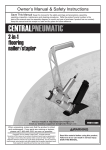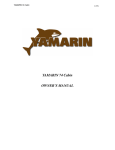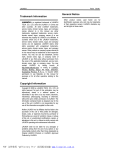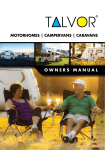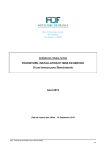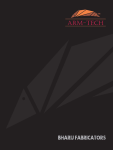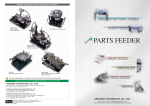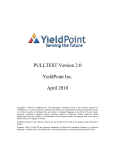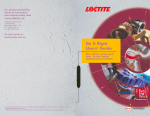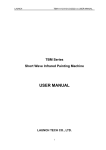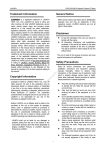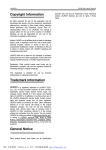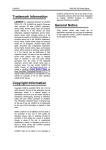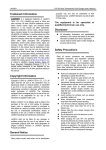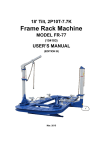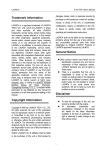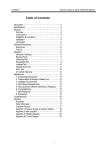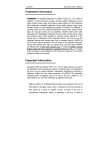Download TCR-101(201) User`s Manual
Transcript
LAUNCH Trademark Information LAUNCH is a registered trademark of LAUNCH TECH. CO., LTD. (short for LAUNCH ) in China and other countries. All other LAUNCH trademarks, service marks, domain names, logos, and company names referred to in this manual are either trademarks, registered trademarks, service marks, domain names, logos, company names of or are otherwise the property of LAUNCH or its affiliates. In countries where any of the LAUNCH trademarks, service marks, domain names, logos and company names are not registered, LAUNCH claims other rights associated with unregistered trademarks, service marks, domain names, logos, and company names. Other products or company names referred to in this manual may be trademarks of their respective owners. You may not use any trademark, service mark, domain name, logo, or company name of LAUNCH or any third party without permission from the owner of the applicable trademark, service mark, domain name, logo, or company name. You may contact LAUNCH by visiting LAUNCH at http://www.cnlaunch.com, or writing to LAUNCH, Xinyang Building, Bagua 4th Road, Shenzhen, Guangdong Province, P. R. C., to request written permission to use Materials on this manual for purposes or for all other questions relating to this manual. TCR-101/201Collision Repair System General Notice Other product names used herein are for identification purposes only and may be trademarks of their respective owners. LAUNCH disclaims any and all rights in those marks. Copyright Information Copyright © by LAUNCH TECH. CO., LTD. All rights reserved. No part of this publication may be reproduced, stored in a retrieval system, or transmitted in any form or by any means, electronic, mechanical, photocopying, recording or otherwise, without the prior written permission of LAUNCH. The information contained herein is designed only for the use of this unit. LAUNCH is not responsible for any use of this information as applied to other units. Neither LAUNCH nor its affiliates shall be liable to the purchaser of this unit or third parties for damages, losses, costs, or expenses incurred by purchaser or third parties as a result of: accident, misuse, or abuse of this unit, or unauthorized modifications, repairs, or alterations to this unit, or failure to strictly comply with LAUNCH operating and maintenance instructions. LAUNCH shall not be liable for any damages or problems arising from the use of any options or any consumable products other than those designated as Original LAUNCH Products or LAUNCH Approved Products by LAUNCH. PDF 文件使用 "pdfFactory Pro" 试用版本创建 www.fineprint.com.cn TCR-101/201Collision Repair System LAUNCH 8. Before each pulling, inspect the chain to make sure it is in good condition. 9. Clamps must be firm attached to the vehicle before each pulling operation is carried out. 10. Make sure the chains and the clamps are firmly attached to the vehicles. 11. Keep away from the front of the column and the pulling direction of the chain to ensure safety. This unit is made for the purpose of persons who have special techniques and certifications. Disclaimer l To take full advantage of the unit, you should be familiar with the engine. l All information, illustrations, and specifications contained in this manual are based on the latest information available at the time of publication. The right is reserved to make change at any time without notice. Warnings Safety Precautions 1. 2. 3. 4. 1. Do not attempt to use Collision Repair System before reading the User’s Manual and Pars Manual. Keep the working area clean and free from obstacles when operating the system. Keep the oil pipes and air pipes in order so that they won’t be pressed during operation. Check and make sure that the cylinders, oil pipes and pumps in the jacks are in perfect working 2. 3. 4. order. Check and make sure that the cylinders, oil pipes and pumps in the pulling systems are in perfect working order. Once the damage is found on the pipes, they should be replaced without delay. If a problem is found in the hydraulic system, repair should be done only be technicians with proper training. Avoid making alterations to the limit valve on the pump. Contact Launch Tech in a timely manner once a problem is found. Keep away from the bench when it is in motion. Keep the pump 0.5m away from the bench. Stay away from the supported bench unless when the mechanical local is engaged. Keep the jack steady when the system is in operation. Better to keep it slow by hand to avoid damage to the equipment and vehicle through operation by foot. When lifting the bench, pin down the other end of the tower to avoid slip. Position the vehicle at the appointed position and place the brake to parking position. Clamping 1. 2. 3. 4. 5. Air source for the pump should be kept away from dust and water. Oil/water separator should be fitted to the air pipes. Once every three months, the filter in the oil /water separator should be replaced. Keep the pressure within .6-0.8MPa. Be fore each use, remaining water should be discharged from the separator. 6. Before lowering the jack, please disengage the mechanical locking system. 7. Make sure the pulling system is firmly connected Make sure there is no oil on the jaws of the clamps before they are used. Inspect if there is distortion or cracking on the parts of the clamp. Replace the parts if such problems are found. Keep the bolts on the clamps and jaws tight. Never use the pin holes at the tower as the holes for the positioning of the vehicles. Measuring and Pulling 1. 2. 3. 4. to the bench. Before each operation, inspection should be carried out. Measuring instruments should be handled with special care so that they won’t be damaged or distorted. Keep the eyes at a parallel position for accurate readout. Inspect if the hooks are damaged. Inspect to make sure that the guiding and locking system are at the same direction and they are not 2 PDF 文件使用 "pdfFactory Pro" 试用版本创建 www.fineprint.com.cn TCR-101/201Collision Repair System LAUNCH 5. 6. 7. distorted. Make sure that the pulling force does not go beyond the limit. Under normal circumstances, the rated load of the tools is 5 tons, chain jointer 8 tons and chain hook 10 tons. Do not knock on the tools and the chains when pulling is in progress. Keep the positioning wedge tight and the pins in place before pulling. 8. Keep away from the same direction as the pulling force of the chains. 9. Keep weight on the tower to prevent improper operation leading to damage. 10. Fix the axel at the other end to the bench when the pulling force is strong. 3 PDF 文件使用 "pdfFactory Pro" 试用版本创建 www.fineprint.com.cn TCR-101/201Collision Repair System LAUNCH Table of Contents ……………………………………………………………………………1 Features ………………………………………………………………………………………………1 Specifications …………………………………………………………………………………………1 General Information Structure ……………………………………………………………………………………………1 Bench …………………………………………………………………………………………………3 Pulling System ………………………………………………………………………………………4 Measuring System ………………………………………………………………………………………5 Tool Kit …………………………………………………………………………………………………7 jack ……………………………………………………………………………………………………9 Operation… …………………………………………………………………………………………10 Preparation before mounting……………………………………………………………………………10 Vehicle Mounting and Clamping ……………………………………………………………………10 Measuring………………………………………………………………………………………………11 Repair Operation ………………………………………………………………………………………13 Maintenance ………………………………………………………………………………………15 Troubleshooting …………………………………………………………………………………16 Appendix 1:Pulling Capacity Of The Clamps …………………………………………18 Appendix 2:Measuring parts and their installation………………………………………19 1 PDF 文件使用 "pdfFactory Pro" 试用版本创建 www.fineprint.com.cn TCR-101/201Collision Repair System LAUNCH General Information Features l l l l l Highly precise decks ensure the accurate measure for the complete image of the damaged area. Dual towers to produce 360o pulling. Equipped with imported hydraulic parts and rods to facilitate pulling to all directions. Movable XYZ dimensioning for accurate and easy operation TCR-201 Collision Repair System has Auto tilting drive-on capacity and hydraulic locking device available. l Optional clamps and accessories to meet the demands for the repair of any collision. l Body reference data keeping updated with the latest in the world. Specifications Items TCR-101 TCR-201 Length 5328mm 5328mm Width 2000mm 2000mm Height 320mm 535mm Weight 2100kg 2300kg Hydraulic Power 69Mpa 69Mpa Power Pulling Capacity 98000N 98000N 360° 360° 0.6~0.8 MPa ———— 0.6~0.8 MPa Sedan Sedan, van, SUV Radius of Pulling Air Pressure Lifting Capacity Adaptable Vehicles 5000kg Structure TCR Collision Repair System mainly consists of four parts: Bench (1 set), Pulling System (2 sets), Measuring System (1 set), and Tool Kit (1 set), as shown in Fig. 1 1 PDF 文件使用 "pdfFactory Pro" 试用版本创建 www.fineprint.com.cn TCR-101/201Collision Repair System LAUNCH a) Structure of TCR-101 Collision Repair System b) Structure of TCR-201 Collision Repair System Fig. 1 Structure of Collision Repair System 1.Bench 2.Pulling System 3.Measuring System 4.Tools kit 2 PDF 文件使用 "pdfFactory Pro" 试用版本创建 www.fineprint.com.cn TCR-101/201Collision Repair System LAUNCH Bench The bench is the base part in Collision Repair System used for the purpose of fixing and repairing vehicles just like an operation table. It mainly consists of 2 parts, Bench Frame and Main Clamps, as shown in Fig 2. Damaged vehicles can be fixed on the bench through clamps and auxiliary support. The main clamps can be fixed on any part of bench frame through pressing plates and bolts. The main clamps position the vehicles by taking hold of undamaged side. It can be adjusted upward under duty. The adjustable scope ranges from 300 to 380mm. When unscrewing the clamp nuts with special socket wrench, the main clamp chops can move flexibly. On the contrary, the main clamps can clamp vehicle skirt edge, so vehicles’ position is fixed. The main clamps are adjustable under duty in the vertical direction. For badly damaged chassis, you can make main clamps directly push upward the damaged part to straighten the vehicle. Auxiliary support is only available on the TCR-201 model for auxiliary clamping, supporting and fixing of the undamaged parts so that they have protection in the process. The adjustable scope ranges from 280mm to 370mm. With adjustable block, the adjustable scope can reach 380mm to 470mm. On top of the auxiliary support, small clamp and positioning pin can function together with craft hole or thread hole on the vehicles to perform auxiliary supporting and positioning functions. 3 PDF 文件使用 "pdfFactory Pro" 试用版本创建 www.fineprint.com.cn TCR-101/201Collision Repair System LAUNCH 1. Bench Frame Fig.2 Bench 2.Main Clamp 3. Auxiliary Clamp Pulling System Pulling System is mainly used for straightening damaged areas on vehicles. It consists of hydraulic cylinder, pneumatic pump and pulling tower, as shown in Fig 3. The pull force needed by straightening is provided by hydraulic cylinder and pneumatic pump. Pulling System can slide along track and can be fixed at any position for 360-degree access to straighten vehicle. According to the vehicle part to be straightened, you can position the pulling system by pulling out the fixing plate, inserting fixing pin and wedging with wedge mass. One end of the chain is fixed in the groove on the upper part of the inner tower column; the other end is connected with clamps which connect the damaged area via idle wheel. The maximum working force is 10t. Manual pump and hydraulic cylinder’s maximum oil pressure is 10000PSI. Hydraulic cylinder is connected with air hydraulic pump or Manual pump. Instructions on the operation and maintenance of the hydraulic cylinder and the pneumatic pump are to be found in the manual coming as a part of the product. Pulling upward can be offered via hanging arm equipped on the upper tower. Hanging arm is locked in the tower by a pin. 4 PDF 文件使用 "pdfFactory Pro" 试用版本创建 www.fineprint.com.cn TCR-101/201Collision Repair System LAUNCH Fig 3 Pulling System 1. Guide Idle Wheel 2. Fixing Mass 3. Fixing Pin 4. Fixing Plate 5.Wedge Mass 6. Hydraulic Cylinder 7. Collar Idle Wheel 8.Pin 9. Hanging Arm Measuring System Measuring System allows the 3-dimention measurement of the chassis so as to find out the distortion in the damaged area of the vehicle. By referring the data of original vehicle, you can decide the direction and the value for the repair. Measuring system consists of measuring ladder and chassis gauge as shown in Fig. 4. Measuring System features convenient operation, flexibility and practical usage. The upper surface of bench will be the base of installation and measurement. 5 PDF 文件使用 "pdfFactory Pro" 试用版本创建 www.fineprint.com.cn TCR-101/201Collision Repair System LAUNCH Fig.4 Mechanism Measuring System 1. Measuring Ladder 2. Chassis Gauge Measuring Ladder Measuring ladder consists of horizontal bar and vertical bar. Chassis gauge can be put on the measuring ladder. It can slide along measuring ladder in the longitudinal direction. Measuring Ladder is located on the machining area of Bench. It is fixed with G-shape clamp. Chassis Gauge Chassis gauge mainly consists of chassis slide seat, chassis cross bar, measuring seat, standard measuring rod, rod extension and measuring parts as shown in Fig. 5. Chassis gauge can slide along measuring ladder as a whole. Measuring seat can slide along chassis crossbar with standard measuring rod. This will allow 3-dimension measurement of the chassis characteristic points. The end of the chassis slide seat pointing to the front of vehicle (with red mark) is the place of longitudinal reading. The place with red mark on the measuring seat is the place of latitudinal reading. The top surface of measuring rod is the place of height reading. There are three set of standard measuring rods and measuring rod seats, which can cover most of measuring points within the scope 130mm to 600mm. Measuring parts include measuring cup, round measuring pointer, L-type measuring pointer and elbow fittings suitable for all kinds of type measuring positions as shown in Fig. 6. The elbow fitting together with measuring cup and round measuring pointer, can measure the position of the characteristic points in the horizontal direction. It will give better convenience for the measurement of some special positions. 6 PDF 文件使用 "pdfFactory Pro" 试用版本创建 www.fineprint.com.cn TCR-101/201Collision Repair System LAUNCH Fig. 5 Chassis Gauge 1. Standard Measuring Rod 2. Measuring Parts 3. Measuring Rod 4. Measuring Seat 5. Chassis Cross Bar 6. Chassis Slide Seat A. Place for Height Reading B. Place for Longitudinal Reading C. Place for Latitudinal Reading Fig.6 1. Round Rod 2. L-shaped Rod 3. Measuring Set 4. Bend Link Rod 5. Tape Rod Tool Kit The tool kit of Collision Repair System mainly consists of vehicle loading ramp, clamps and special tools and can meet the needs for collision repair. Vehicle Loading Ramp Vehicle loading ramp is used to guide vehicle move on Bench. 7 PDF 文件使用 "pdfFactory Pro" 试用版本创建 www.fineprint.com.cn TCR-101/201Collision Repair System LAUNCH Clamps Clamps are defined as tools that work to hold damaged area on the vehicle. Clamps fall in different types in accordance with the damaged areas. Repair System. They are flexible to use. There are dozens of clamp types in TCR Collision Convenient clamping and safety should be taken into consideration when using the clamps and caution should be taken not to damage the structural parts. Some typical clamps are shown in Fig. 7. Among them 1 and 2 are mainly for coating, and 3 and 4 are mainly used for frames such as bumper. Fig 7 Typical Clamps 1. Clamp Splint with Chain 2. Dual Chains Clamp Splint 3. Big Hook 4. Small Hook Special Tools Special tools are shown in fig 8. Special tools include socket wrench and hex. wrench. Socket wrench is specially used to fasten jigs and clamps. Hex. wrench is mainly used to fasten clamps. Special tools can increase your efficiency. Fig 8 Special Tools 1.Socket Wrench 2. Hex. Wrench 8 PDF 文件使用 "pdfFactory Pro" 试用版本创建 www.fineprint.com.cn TCR-101/201Collision Repair System LAUNCH Tool Rack Tool rack is used to hold accessories of the equipment, as shown in Fig 9. It is equipped with foot wheels for convenient movement. Some special rigs are found on the tool rack, such as pothook and small case. Fig 14 Tools Storage Cart 1. Pot hook 2. Wheel 3. Box Jack(for TCR-201 only) Structure The jack consists of main lift frame, oil cylinder and air hydraulic pump, as shown in Fig. 10. 1. Main Jack 6. Oil cylinder 2. Check Valve 7. Air Cylinder Fig 10 TCR-201 Jack 3. Air Hydraulic Pump 4. Two-position Five-way Valve 8. Ratchet Operations 9 PDF 文件使用 "pdfFactory Pro" 试用版本创建 www.fineprint.com.cn 5. Pawl TCR-101/201Collision Repair System LAUNCH the operation instruction of Working Platform Lift Frame is described as following. Ø Ø Ø Ø Connect the outlet of the air pump with the inlet connector of the two-position five-way valve. After bleeding the residue air in the oil pipe, connect the other end of the oil pipe with the cylinder. Check the part to make sure that the connection is reliable and there is no leakage. Set the air pressure value of the air pump to 5.8 bar. Turn on the electronic source switch so that the air pump will supply air. Push out the handle of two-position five-way valve then depress the switch of air-hydraulic pump toward PRESSARE (PUMP). This will enable the bench to move up. Release the switch of air-hydraulic pump at this time, the bench will stop and keep at a certain position. To lower the bench, push in the handle of two-position five-way valve to release the pawl from the ratchet, then depress the switch of the air-hydraulic pump toward RELEASE position. If the air cylinder can’t lift the pawl of the mechanical self-lock jig, extend the oil cylinder and lift the bench by 5~10cm, then repeat the above steps to move the bench. Operations Preparation before Mounting Set the repair plan According to the damages on the vehicle, set the parts and the directions to be pulled and protected during the pulling process. When necessary, remove some parts, for example, the battery. Find out the chassis data and the body data suitable for the damaged vehicles Ø Ø Find out the category, model, manufacturer, and year of the damaged vehicle and trace the number of the vehicles from the catalogue. Find the respective chassis data and vehicle’s body data through the number of the vehicle in the reference. Vehicle Mounting and Clamping Mounting Drive or pull the vehicle to be repaired via winch onto the bench along mounting ramp. ramp to finish the process. Remove the mounting Vehicle Clamping l Clamping of vehicles with front or rear damages a. Mount the clamp bases (It is not necessary to remove the clamp bases after each mounting. b. Mount the four clamps on the clamp bases, and adjust the height of the clamps to 350mm. c. Move the scissors lift to one end of the vehicle, and lift it up. Use a couple of clamps to clamp the skirt edge of the vehicle. Then move the lift frame to the other end of vehicle. Use another couple of clamps to clamp the vehicle’s respective skirt edge and finish the clamping as shown in Fig 11. 10 PDF 文件使用 "pdfFactory Pro" 试用版本创建 www.fineprint.com.cn TCR-101/201Collision Repair System LAUNCH l Fig 11 Mounting and clamping vehicles with damage on one side The process of mounting and clamping is similar to the ones with damages on the front or rear. The difference is when edge is damaged, clamping can’t be done or the edge can only hold one clamp. Under this condition, use two clamps to hold the edge of vehicle not damaged and use the accessory clamps to support, clamp, and fix the good parts. According to the condition of the vehicle edge, lift and lower the clamp, and clamp the damaged side. Then pull and straighten the damaged side. When the repair of the damaged side is completed, clamp this side so pull the other damaged parts. l Mounting and clamping vehicles without skirt edge If there is no skirt edge on the vehicle to be repaired, you can weld two couples of steel slats symmetrically on the suitable position of its chassis. After loading the vehicle, you can clamp it via the four steel slats. l Mounting and clamping crossbeam type vehicles The skirt edge of the crossbeam type vehicle is weak, so it is not suitable for clamping. If necessary you may clamp skirt edge to perform as assistant support. Generally the clamped parts of crossbeam type vehicle are the suspension fulcrum and the front part of the crossbeam. You shall use crossbeam special clamp (optional) to clamp the front of crossbeam and use outer suspension bracket (optional) to support the suspension fulcrum. You can use accessory clamp and accessory support to fix the crossbeam type vehicle. Note: l l l l In the process of loading the vehicle, keep the longitudinal centerline of the vehicle to the longitudinal centerline of the bench. After mounting the vehicle, try to locate its gravity center in the middle part of the bench. If the vehicle is longer than the bench, move the vehicle so that the damaged part is located on the bench so that pulling can be performed. After mounting the vehicle, use small clamp, position pin, and positioning jacketing as assistant support. Measuring When using measuring system, you shall have a good understanding of the data table in the measuring system at 11 PDF 文件使用 "pdfFactory Pro" 试用版本创建 www.fineprint.com.cn TCR-101/201Collision Repair System LAUNCH first. Description Of The DataTable The vehicle body data provided with the equipment includes chassis data table and body data table. All kinds of measuring items in chassis data and their ways of installation are shown in Appendix 1. Measuring System Positioning After mounting the damaged vehicle, take a roughly measure and work out a repair plan. During the repair process, you shall take a precise measure of the part to be repaired, so that you can judge if it is well done. When using the measuring system, you should perform calibration first. The operation method is listed below. Ø Locate two points in the undamaged area on the front or on the rear of the chassis by referring to the data Ø Ø table suitable for the vehicle. In general the rear point is the front fulcrum of the rear suspension (When the point is damaged you may choose other points). In the data table the front fulcrum of the rear suspension fulcrum is marked with O. According the absolute latitudinal distance and altitudinal distance, you can determine another point on the vehicle. Put the measure ladder on the bench, and mount the four sets of chassis rulers on the measuring ladder. In general the rear set of chassis rulers shall use the short crossbeam ones. According the installation type illustrated in the data table, you can install the measuring rob and the measuring elements well. Adjust chassis measuring ruler, measuring sliding seat and measuring position to make the numbers in accordance with the numbers illustrated in data table. And brick by brick adjust the measuring ladder’s position to make the measuring elements correspond to the positioning point (2-mm error is allowed). Tighten the tacking screws. Notes: The data table given is in accordance with vehicles of some special type and some special year. Due to the rapid progress and the improving of the manufacture technology, vehicle made by the same manufacturer but in a different year may have different data. When using data table, note that the measuring precision of the system is 2 mm., but in most cases tolerance of the vehicle manufacturer is under 3 mm. More over because of the manufacture technology, the tolerance of the chassis and vehicle body is 10 mm at times. l l Operation of measuring system Installation of the chassis measuring ruler and the gantry measuring frame After the calibration of the measuring system, you shall install the gantry-measuring frame and other chassis-measuring ruler and measuring elements, etc. The installation approaches are described below. Ø Ø Ø Remove the measuring sliding seat, measuring seat and measuring rod. Place the chassis crossbeam assembly on the measuring ladder. Place the measuring sliding seat, measuring seat and measuring rod on the chassis crossbeam. Measurement of the Chassis l Measuring the characteristic points of the chassis Ø According the character of the chassis measuring point and the measuring method illustrated in the data table, you can select the appointed measuring rod and measuring 12 PDF 文件使用 "pdfFactory Pro" 试用版本创建 www.fineprint.com.cn TCR-101/201Collision Repair System LAUNCH elements and fix them together. Ø Adjust the position of the chassis ruler, measuring sliding seat, and measuring rod to make the elements touch the measuring point. Ø Read the portrait, landscape, and height number illustrated by the chassis ruler. And compare them with the number illustrated in the data table. If the error is in the range of 2 mm, the point position is correct. Otherwise it is incorrect. l Measuring vehicle when there is no available data If no data table is available for the vehicle to be repaired, follow the method below. Ø Find two sets of symmetrical points in the area not damaged. The distance between the two sets of symmetrical points shall as apart as possible. Calibrate the measuring system with reference to the two couples of symmetrical points. Ø Measure the vehicle by traditional means or on the basis on some of the key structural dimension or installation dimension. Making use of the Experience may be equally important in the measurement of the vehicle. Note: The distance between the two sliding seats on chassis measuring ruler is well adjusted before it leaves the factory. Do not loose the screws on the track. If the clearance between the chassis-measuring ruler and measuring ladder is too long after long use, loose the screws to adjust the clearance. The chassis on the left and right measuring ruler shall be symmetric based on the center line of the chassis ladder. The adjustment error shall not be greater than ±0.5 mm. Repairing Operation Preparations l Remove the battery to avoid possible erosion from leakage of the acid. l Remove the parts in the way during the repairing process. l Measure the vehicle and set the repairing plan. Connection of the pulling system and the bench At first set the suitable connection point in accordance with the part to be repair. The following principles shall be observed: During the process repairing, when some part being applied stronger force, the chain shall be kept parallel to the towers’ crossbeam to protect the tower from being damaged. After the connection position being ascertained, the positioning mass shall be pulled out. Insert the positioning pin, and then wedge it with wedging mass. This will fit the pulling system with the bench tightly. Connection of the hydraulic system and pulling system Fit together the manual pump, oil pipe and oil cylinder. Check the oil level in the manual pump. If the level is too low, fill hydraulic oil (refer to the detail method in the user’s manual). Remember to exhaust the air in the oil pipe. Connection of pulling tower and calibration point Select the clamps to be used in accordance with the damaged parts. For the rigid parts the pulling hook, pulling plate and big clamps shall be selected in general. Connect the clamps and the chains reliably. Fix the other end of 13 PDF 文件使用 "pdfFactory Pro" 试用版本创建 www.fineprint.com.cn TCR-101/201Collision Repair System LAUNCH the chain in the chamber on the upper part of the inner tower beam. Repairing Operation Turn off the switch of the manual pump. Rock the handle of the manual pump repeatedly so that oil comes from the pump and the cylinder is extended. During the repairing process, adjust the height and position of the chain as well as the connection position in the pulling system. Typical pulling operation l When some of the damaged parts need to be pulled downward, change the chain direction via idle wheel as shown in Fig. 12. l l l The straightening of the rear of the vehicle is shown in Fig. 13. When the top of the vehicle body needs to be pulled upward, use the hanging bar as shown in Fig. 14. When the top of the vehicle body needs to be pulled upward, use the pulling tower to perform the task as shown in Fig. 15. Fig. 12 Fig. 13 Pulling Downward Pulling of the Rear Parts 14 PDF 文件使用 "pdfFactory Pro" 试用版本创建 www.fineprint.com.cn TCR-101/201Collision Repair System LAUNCH Fig. 14 Pulling the Top Upward Fig. 15 Pulling the Top Upward Notes: l Some parts shall be supported and fixed according to the feathers of straightening. For example, when pulling downward some damaged points on the chassis, you shall support or fix the start point of the crook. When the top part is straightened, the front end of the vehicle or the rear end of the vehicle chassis shall be fixed. And when the front end of the vehicle is pulled toward left or right, you must fix the front end of the chassis. l Measuring system shall be moved to the undamaged area to avoid the chain and accessories in the measuring system from being destroyed. l Keep away from the back of the pulling tower during the process of straightening. Maintenance l After each use, clean up replace the clamps and the measuring parts. l The hydraulic oil in the cylinder, air hydraulic pump and manual pump shall be replaced once every half a year 15 PDF 文件使用 "pdfFactory Pro" 试用版本创建 www.fineprint.com.cn TCR-101/201Collision Repair System LAUNCH l l l in the way as illustrated in the manual. Change the hydraulic oil after using for three months. After the hydraulic pump is cleaned up, fill in hydraulic oil. Add lubricant to the rails of the tower on a regular basis to ensure its flexible movement. When the pneumatic pump and oil cylinder are not in use, keep the dust caps on so that dust won’t get into the pump and cylinder. Troubleshooting Symptom Cause Solution 1. Sealer is broken 2. Serious wear of piston 1. Replace the cylinder sealer 2. If leak is still serious after the sealer is replaced, there may be serious damage at the piston, which should be replaced 2 Oil leakage at cylinder coupler Improper connection between the couplers Remove the coupler or quick coupler, wrap on sealing tape before fasten the coupler back on. If the leakage is still seriously, change the coupler. 3 Oil leakage coupler Improper connection between the couplers Remove the coupler or quick coupler, wrap on sealing tape before fasten the coupler back on. If the leakage is still seriously, change the coupler. 1. Improper sealing at the couples. 1. Remove the coupler or quick coupler, wrap on sealing tape before fasten the coupler back on. If the leakage is still seriously, change the coupler. 1 4 Oil leakage at cylinder piston at pump Oil leakage at pipes 2. Pipe burst. 5 6 7 Cylinder piston can reach the place Cylinder can not retract. Weak in lifting and pulling force 2. Replace the oil pipe. Low oil level in the pump Check the pump and add oil. 1. Air resistance found in cylinder. 2. The couplers are not tightly fastened so that the check valves are not fully contacted. This has resulted in the difficulty in oil return. 1. Low pressure at air source. 2. Leakage at air pipes, hydraulic pipes and adaptors. 3. Block at the inlet of hydraulic pump 4. Check valve not 1 (a) Press repeatedly to release pressure and return air to oil box. (b) Use jack in place of cylinder support. Screw down the cylinder coupler so that the piston returns completely to the cylinder. After pushing out oil and air, replace the couplers and pipes. 2 Tighten quick couplers. 1. Check the air pressure to make sure it is between 0.6MPA and 0.8MPA. 2. Handle in the ways described above. 3. Contact Launch Tech. 4. Contact Launch Tech. 16 PDF 文件使用 "pdfFactory Pro" 试用版本创建 www.fineprint.com.cn TCR-101/201Collision Repair System LAUNCH completely because substance. 8 Hydraulic pedal does not respond 9 No pressure hydraulic pedal at the 10 Pressure is not held in hydraulic pump. 11 Oil leakage under the pump pedal of blocked foreign 1. Air passage is not open. 2. Control valve is damaged. 3. Too much water and dirt in the pump. 1. Oil outlet is blocked. 2. Check valve or overflow valve is blocked or damaged. 1、Air turned off or line blocked, 1. Open the air passage. 2. Contact Launch Tech. 3. Contact Launch Tech. Contact Launch Tech. 1. Oil leakage 2. Check valve or overflow valve is blocked or damaged. Contact Launch Tech. Sealing pad damaged Replace the sealing pad. 17 PDF 文件使用 "pdfFactory Pro" 试用版本创建 www.fineprint.com.cn TCR-101/201Collision Repair System LAUNCH Appendix 1: Pulling capacity of the clamps Order 1 Item Universal plate Specifications Pulling capacity 01 4 tons when the pulling is in the same direction with the jaw 3 tons hen it is vertical 2 Chassis hook 02 5 tons 3 Clamp with chains 03 3 tons 4 Large hook 04 5 tons 5 Chain clip 5104 8 tons 6 Wide clip 06 8 tons 7 Dual clamp 08 3 tons 8 Functional wheel 09 5吨 9 Long pad 10 5 tons 10 Horizontal plate 12 5 tons 11 Vertical plate 13 5 tons 12 Fiber suspension φ1000(Hood) 2 tons 13 Beam plate 11 5 tons 14 Suspension chain 14 8 tons 15 Chain 3m 10 tons 16 Universal shock absolver seating 15 5 tons 17 Strong Clamp M1 5 tons 18 C type Clamp M2 5 tons 19 Narrow clamp M4 5 tons 18 PDF 文件使用 "pdfFactory Pro" 试用版本创建 www.fineprint.com.cn TCR-101/201Collision Repair System LAUNCH Appendix 2: Measuring parts and their installation Measuring tools Example Remarks Measurement of interior points or holes Measurement of interior points or holes on a vertical plane Measurement of larger holes Measurement of larger holes on a vertical plane Measurement of the position of bolt Measurement of the position of bolt on a vertical plane Measurement of 90º right angle square 19 PDF 文件使用 "pdfFactory Pro" 试用版本创建 www.fineprint.com.cn TCR-101/201Collision Repair System LAUNCH Measuring tools Example Remarks Measurement of interior points or holes Measurement of interior points or holes on a vertical plane Measurement of the position of bolt Measurement of 90º right angle square Measurement of 90º right angle square Measurement of 90º right angle square Mechanical measurement for leveled plane 20 PDF 文件使用 "pdfFactory Pro" 试用版本创建 www.fineprint.com.cn LAUNCH Warranty THIS WARRANTY IS EXPRESSLY LIMITED TO PERSONS WHO PURCHASE LAUNCH PRODUCTS FOR PURPOSES OF RESALE OR USE IN THE ORDINARY COURSE OF THE BUYER’S BUSINESS. LAUNCH electronic product is warranted against defects in materials and workmanship for one year (12 months) from date of delivery to the user. This warranty does not cover any part that has been abused, altered, used for a purpose other than for which it was intended, or used in a manner inconsistent with instructions regarding use. The exclusive remedy for any automotive meter found to be defective is repair or replacement, and LAUNCH shall not be liable for any consequential or incidental damages. Final determination of defects shall be made by LAUNCH in accordance with procedures established by LAUNCH. No agent, employee, or representative of LAUNCH has any authority to bind LAUNCH to any affirmation, representation, or warranty concerning LAUNCH automotive meters, except as stated herein. TCR-101/201Collision Repair System E-mail: [email protected]. If your unit requires repair service, return it to the manufacturer with a copy of the sales receipt and a note describing the problem. If the unit is determined to be in warranty, it will be repaired or replaced at no charge and returned freight pre-paid. If the unit is determined to be out of warranty, it will be repaired for a nominal service charge plus return freight. Send the unit pre-paid to: Attn: Overseas Department LAUNCH TECH. CO., LTD. Xinyang Building, Bagua 4th Road, Shenzhen, Guangdong Province, China Disclaimer THE ABOVE WARRANTY IS IN LIEU OF ANY OTHER WARRANTY, EXPRESSED OR IMPLIED, INCLUDING ANY WARRANTY OF MERCHANTABILITY OR FITNESS FOR A PARTICULAR PURPOSE. Order Information Replaceable and optional parts can be ordered directly from your LAUNCH authorized tool supplier. Your order should include the following information: 1. Quantity 2. Part number 3. Item description Customer Service If you have any questions on the operation of the unit, please contact us: Tel: 86-755-82401364 or 86-755-82269604 PDF 文件使用 "pdfFactory Pro" 试用版本创建 www.fineprint.com.cn

























